Ijraset Journal For Research in Applied Science and Engineering Technology
- Home / Ijraset
- On This Page
- Abstract
- Introduction
- Conclusion
- References
- Copyright
Maintaining Security and Achieving Transparency in Charities
Authors: Prof. Mrs. A. H. Renushe, Miss. Mane Shrutika Vidhyanath, Mr. Jadhav Manish Prakash , Mr. Sonawale Omkar Ganpat, Mr. Jamdade Sourabh Vishnu
DOI Link: https://doi.org/10.22214/ijraset.2022.41184
Certificate: View Certificate
Abstract
While analyzing the problem we thought about the importance with respect to data security. Since everything is getting digitalized, security is the key point in this digital era. So, when it comes to data security or data integrity, there are serval ways through which we can achieve this. So, we started finding loop holes in digitize donation system. As this way we came on the conclusion that there are loop holes in the charity system. Hence, we have decided to use the most spectacular data security related technology i.e., “blockchain”. We are going to implement blockchain technology in this proposed system, so that whatever transaction / donation done between donor and beneficiary will be transparent and open to world. which will ultimately reduce chances of corruptions usually happen in the donation system.
Introduction
I. INTRODUCTION
We started finding loop holes in digitize donation system. In this way we came to the conclusion that there are loop holes in the charity system.
Hence, we have decided to use the most spectacular data security related technology i.e., “blockchain”. We are going to implement blockchain technology in this proposed system, so that whatever transaction / do- nation done between donor and beneficiary will be transparent and open to world. Blockchain is the world's leading software platform for digital assets and it plays a lead role in crypto currency market. It is very easy to transfer money overseas. Which will ultimately reduce chances of corruptions happen in the donation system.
The charity system mode proposed the use of blockchain technology to solve prob- lems in social emergency assistance. also analysed the application of blockchain technology in India’s philanthropy and af- firmed the advantages of blockchain tech- nology in philanthropy. Blockchain tech- nology proposed to manage the assistance funds in disaster area and establish the en- tire platform on Ethereum.
The blockchain system can bring transparency to online charity trusts. Con- tributors can see the journey of the dona- tion in real time and confirm if it’s reach- ing the deserving hands or not. With the addition of blockchain into charities, do- nors would no longer be unaware of what’s being done with their money. dona- tion information would be stored in blocks
Important aspects of a system are as follows:
- Donor: In this module, user can register in our system as a donor using credentials and unique wallet address where he can view the campaigns and their details. And after selecting project for donation, he/she proceed for donation. The system will check the balance of donor’s account. Do- nation can be complete if balance is sufficient.
- Beneficiary: The people who need help should fill the information which will be uploaded to the charity organization for review, and the approved projects will be posted on the charity platform. In this module, user can register in system as a beneficiary using credentials and unique wallet address. After registration beneficiary can create campaigns with their de- tails such as images, goals, required amount, duration. beneficiary can view all transactions related to campaigns. Beneficiary can get report of their own campaigns in which he/she will get information related to donated amount and their information
- Charity Organization: The organization can get donation from the platforms to help other people. also, it will check the forms filled by the beneficiary. If all de- tails are founded true then only campaign is display on web page otherwise it can’t.
- Issue Token Module: In this module, do- nor can request for the ERC20 token for donation purpose. While requesting for the tokens donor needs to pay as per the ex- change of token rate to the system through online payment/ UPI. After requesting for the token’s admin will view the request and then issue the tokens after confirming the payment done by the donor.
- Infura Module: Infura is a hosted Ethereum node cluster that lets you make request to the ETH-1 blockchain without requiring you to setup your own ETH-1 node. Infura is a blockchain development suite that provides application programming inter- faces (APIs) and developer tools. It accesses to the Ethereum network to enable developers to build sophisticated next generation software and Web3 applications that scale to meet user demand. Infura offers top of-the-range documentation and resources to help developers build decentralized applications (Dapp) quickly. It provides the tools and infrastructure that allow developers to easily take their block- chain application from testing to scaled deployment.
- Meta-Mask Module: Meta mask is a browser extension/ app design to make accessing Ethereum Dapp ecosystem easier. It also surfs as a wallet for holding ERC-20 tokens allowing users to access services built on the network via the wallet. In our project we used meta mask ex- tension/ app for managing user’s private keys securely. It provides features like accessing multiple accounts at one place which we can used in mobile devices also with browser extension. The meta mask supports multiple networks like Ethereum, BSC, polygon, Matic.
II. LITERATURE REVIEW
- Research on Charity System Based on Blockchain. Hangzhou Institute of Service Engineering, Hangzhou Normal University, Hangzhou, author- hu- baokun (2020). The charity organizations in India having lack of transparency. and supervision to them is difficult to achieve, which has a negative impact on the willingness of the people to donate. Block- chain as an underlying technology of Bitcoin system provides a new solution for the charity system in terms of technology. This paper proposed a charity system based on blockchain technology and ex- pounds the design pattern, architecture and operational process of the platform. Some core functions of the charity platform have been realized and verified on Ethereum. We hope to increase the transparency of charities to enhance the people trust in charities and promote the development philanthropy by blockchain-based charity system.
- Research on Bitcoin: A Peer-to-Peer Electronic Cash System. Author: Satoshi Nakamoto (2008). Before implementing blockchain into our project, we first need to understand how blockchain works, how it is implemented onto the network. A purely peer-to-peer version of electronic cash would allow online payments to be sent directly from one party to another without going through a financial organization. This paper proposed a peer- to-peer electronic cash transaction through blockchain. Which we will be using in our respected project for the transaction pur- pose. Digital signatures provide part of the solution, but the main benefits are lost if a trusted third party is still required to prevent double-spending. We propose a solu- tion to the double-spending problem using a peer-to-peer network. The network timestamps transactions by hashing them into an ongoing chain of hash-based proof- of-work, forming a record that cannot be changed without redoing the proof-of- work.
- Developing a Reliable Service Sys- tem of Charity Donation During the Covid-19 Outbreak. HANYANG WU 1,2 AND XIANCHEN ZHU 1 1School of Economics and Management, Nanjing University of Science and Technology, Nanjing 210094, China 2School of Eco- nomics and Management, Jilin Institute of Chemical Technology (2020). Resisting major disasters has become a common global topic, and strengthening the governance of them is an essential field of charity. All countries attach importance to strengthening close cooperation between the public and private sectors, various non-governmental organizations and scientific research institutions, and have formed a multi-party cooperation mechanism for disaster relief and disaster reduction. A charity donation can quickly organize work on disaster relief, which is an essen- tial part of social forces in such a situation. Blockchain technology is to provide de- centralized ledgers whose distribution is in the form of cryptography in chronological order. Each block is a linked data structure in the form of a linked list. The data in the block cannot be tampered but can be veri- fied in the system, and they can be stored safely in a sequential relationship. Data are distributed through an extensive, distribut- ed, and incorruptible network of comput- ers.
- Blockchain smart contracts: Appli- cations, challenges, and future trends. Author: Shafaq Naheed Khan1 · Faiza Loukil2 · Chirine Ghedira-Guegan3· Elhadj Benkhelifa4 · Anoud Bani-Han (2021). In recent years, the rapid development of blockchain technology and cryptocurren- cies has influenced the financial industry by creating a new crypto-economy. Then, next-generation decentralized applications without involving a trusted third-party have emerged this is due to appearance of smart contracts, which are computer proto- cols designed to facilitate, verify, and en- force automatically the negotiation and agreement among multiple untrustworthy parties. Despite the bright side of smart contracts, several concerns continue to un- dermine their adoption, such as security threats, vulnerabilities, and legal issues. Here, we found comprehensive survey of blockchain-enabled smart contracts from both technical and usage points of view. we identify a set of challenges and open issues that need to be addressed in future studies. Finally, we identify future trends.
- Managing charity 4.0 with Block- chain: a case study at the time of Covid- 19.University G. D’Annunzio of Chieti- Pescara, Viale Pindaro, 42, 65127 Pe- scara, Italy. Corresponding author: Adalberto Ragone. The Covid-19 emergency is demonstrating the need to follow new solutions that can support the important role played by non- profit organizations around the world. Contrary to what should have happened to further combat the effect of pandemic, the majority of philanthropic organisations had a negative impact on fundraising, suf- fering a substantial decrease. Today, the Blockchain can play a pivotal role to re- establish pre-pandemic standards and en- hance the development of global philan- thropy. The available literature provides countless insights that can allow us to in- vestigate the evolutionary trends and the quality of the flows of donations to non- profit entities over time and under numer- ous perspectives. Authors such as James, Mainardes et al. Bakers and Wiepking provided important studies on donations flows by analyzing qualitative and quanti- tative as well as social aspects. Some au- thors instead pleaded an approach related to psychological principles, often due to the evidence of donations already made or the empathy of donors and the emotions aroused. Nevertheless, in the context of the literature review, in our opinion some analyses emerged more than other. They clarify the close correlation between the legitimization factor. the ability to create serious and efficient donation models as well as the reputation of non-profit organi- zations and an increase in donations.
- Review of Distributed Ledgers: The technological Advances behind crypto- currency. Author: Suvarna K. Kadam Department of Computer Engineering, D. Y. Patil College of Engineering Akurdi (2018). Blockchain and related Distributed Ledger Technologies (DLT) are proving to be the ground breaking and likely to change the role of web from centralized document sharing platform to a generic de- centralized platform that can exchanged digital currency and help autonomously manage financial and real-estate assets. Distributed Ledger Technology (DLT) are one of key technologies responsible for bringing the openness of web back without compromising its security. The commer- cial and legal transactions can now be handled completely on the web as DLTs provide more secure and accountable envi- ronment for exchanging digital assets in the forms of currencies, popularly known as cryptocurrency. The paper reviews the recent advances in DLTs. And also, the recent cryptocurrencies along with the re- lated distributed ledger technology (DLT) employed to realize that cryptocurrency is discussed. The review concludes with im- pact of DLT on the future of the Web.
- An Overview of Smart Contract and Use cases in Blockchain Technology. Author: Bhabendu Kumar Mahanta, SoumyaShree S Panda, Debasish Jena IIIT Bhubaneswar Odisha, India (2018). In the last decade blockchain technology become mainstream research topic because of its decentralized, peer to peer transac- tion, distributed consensus, and anonymity properties. The blockchain technology overshadows regulatory problem and tech- nical challenges. A smart contract is a computer program having self-verifying, self-executing, tamper-resistant properties. The smart contract concept was proposed by Nick Szabo in 1994. It allows executing code without the third parties. A smart contract consists of the value, address, functions, and state. It takes transaction as an input, executes the corresponding code and triggers the output events. Depending upon the function logic implementation states are changes. Since 2008 when blockchain technology come into existence through Bitcoin cryptocurrency. The im- portance of smart contract integration of blockchain technology become a focus area to develop because it gives peer to peer transaction and database can be maintained publicly in a secure way in a trustful envi- ronment. Smart contracts are trackable and irreversible. All the transaction infor- mation is present in a smart contract and it executes automatically. The programming language Solidity is used to implement the smart contract in various blockchain plat- forms.
- A block chain based decentralized exchange. Author: Harsh Patel. A pure peer to peer version of the ex- change system would allow all parties ac- cess to the market without relying on any central organization for market access. Pa- per proposes a solution for the problem of maintain an order book and determine the execution rate in the peer-to-peer network. Like cryptocurrencies the network relies on blockchain of transaction. Digital signa- ture system would be the core of the de- centralized market place. The paper de- fines basic ground rules for the working of decentralized exchange. The major com- ponents of the decentralized exchange are issuing process, co-existence of blockchain and order books and functions of the min- er. Unlike other crypto currencies de- centralized exchange would have a trust- based issuing process which in long run would be a sum zero game. The decentral- ized Exchange would have 3 types of enti- ties namely – Issuer, Trader and Miner. Were issuer being the entity who is the ini- tial starting point for the decentralized ex- change, trader is the entity that places the order to either buy / sell a defined quantity, and miners are entities who constantly lis- ten to the network for successful transac- tion broadcasted by the nodes.
- A Study of Private Donation System Based on Blockchain for Transparency and Privacy. Author: junho jeong [Sci- ence and Engineering Kongju National University, Cheonan, Rep. of Korea] (2020). Nowadays, social inequality is an im- portant social problem. Donations are one of the many ways to improve social ine- quality. Donation is largely divided into sponsorship by individuals such as corpo- rations and public administration. In the individual sponsorship, it is common to donate to a donation organization and to support the aid recipients by donation or- ganization. Many people are reluctant to support to this donation because of the lack of transparency. In addition, many donation organizations lack transparent and formal administration due to lack of working capital. Therefore, this paper pro- poses a method to enhance personal trans- parency by enhancing the transparency of donation organizations and protecting the privacy of sponsors using blockchain that is a Hyperledger fabric.
- An Investigation of Fraud in Non- profit Organizations: Occurrences and Deterrents. Author: Janet Greenlee, Mary Fischer Teresa Gordon and Eliz- abeth Keating. [The Hauser Centre for Non-profit Organizations Harvard Uni- versity]. Losses due to fraudulent activities are par- ticularly troublesome in the non-profit sec- tor because they directly reduce resources available to address tax-exempt purposes. The ensuing bad publicity may also reduce contributions and grants in subsequent pe- riods. This paper uses data provided by Certified Fraud Examiners to report on the types of fraud they identified in non-profit organizations and the characteristics of both the victims and the perpetrators of the fraudulent activities. Based on the analysis of the data, the authors suggest ways that fraud losses can be prevented or mitigated. In particular, governing boards are urged to consider important controls in addition to the annual financial statement audit.
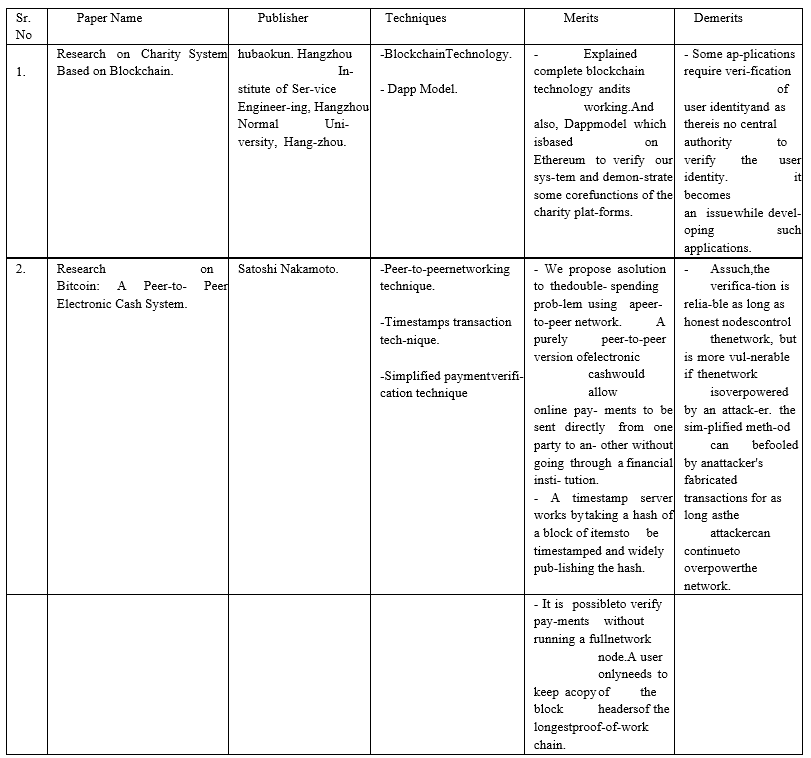
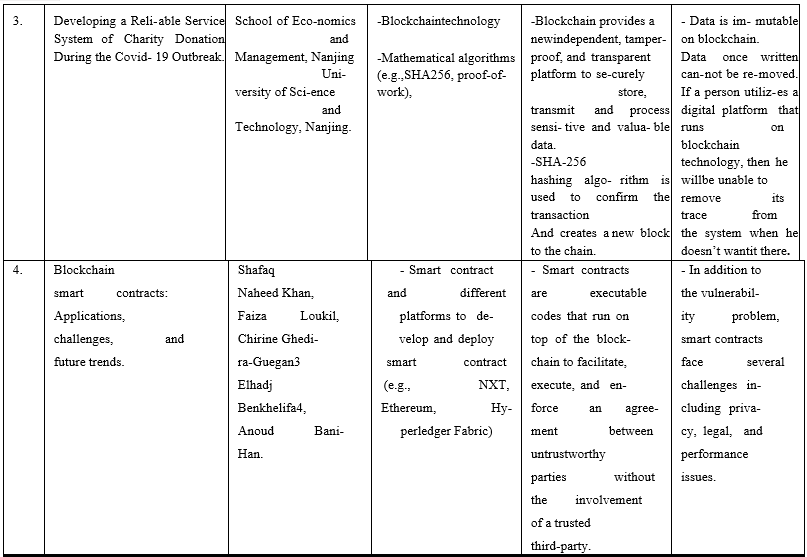
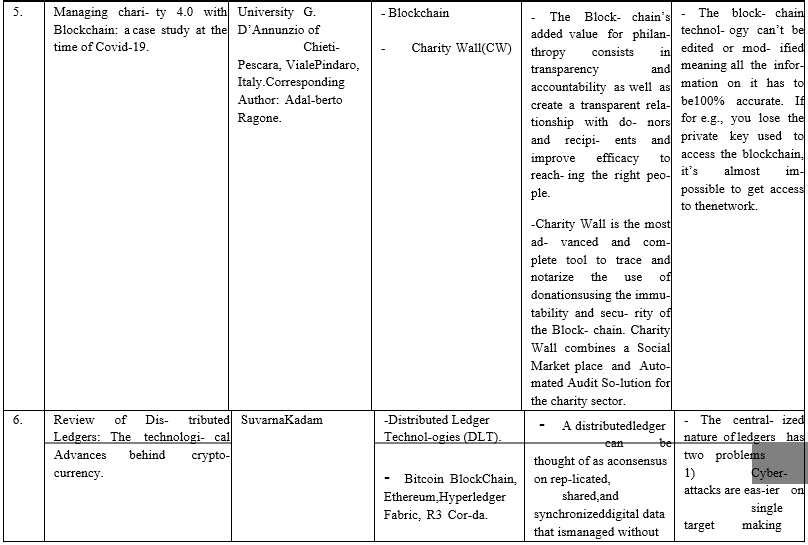
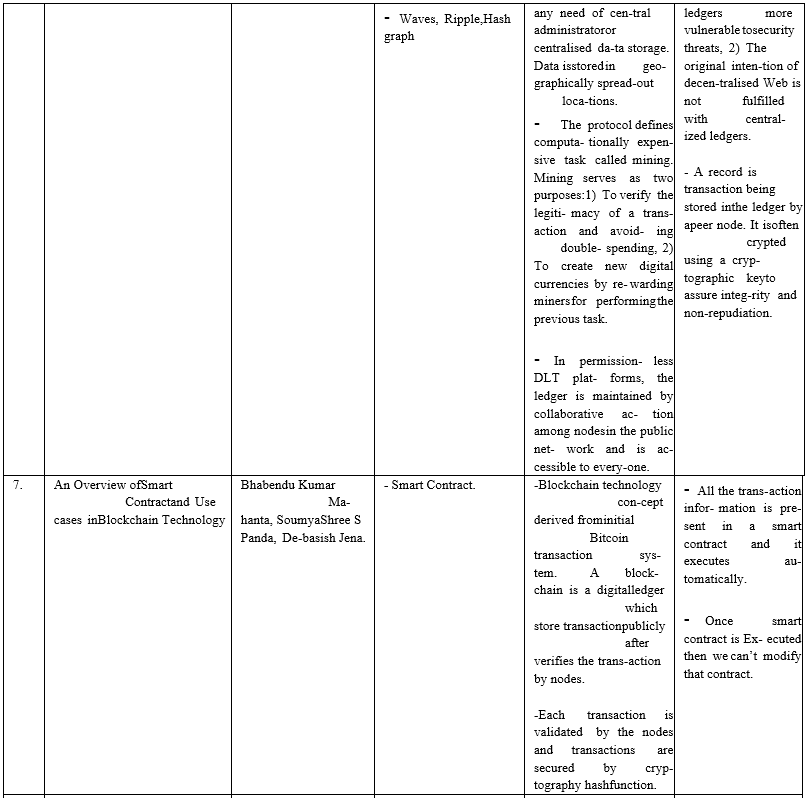
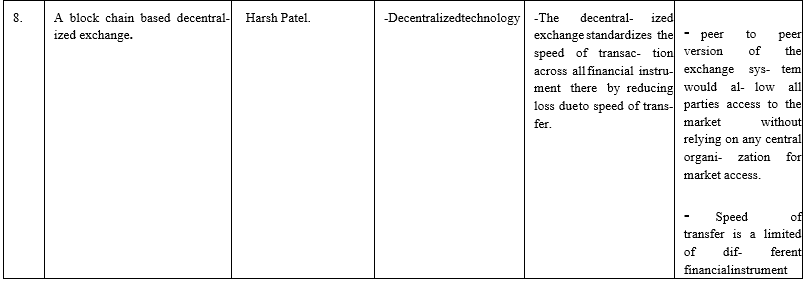
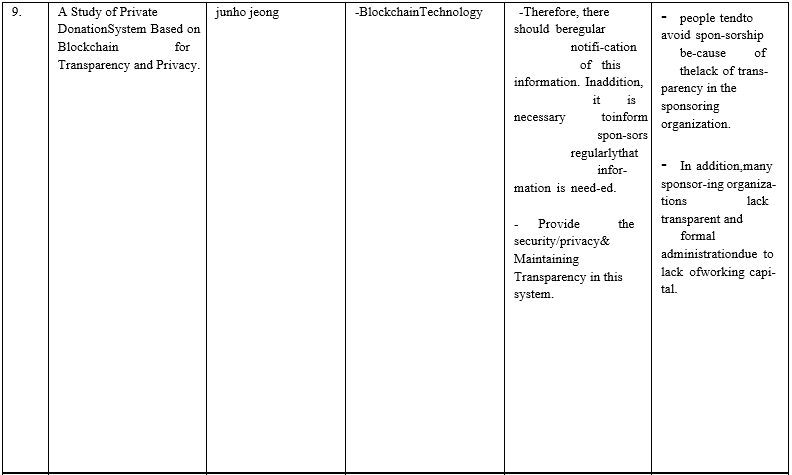
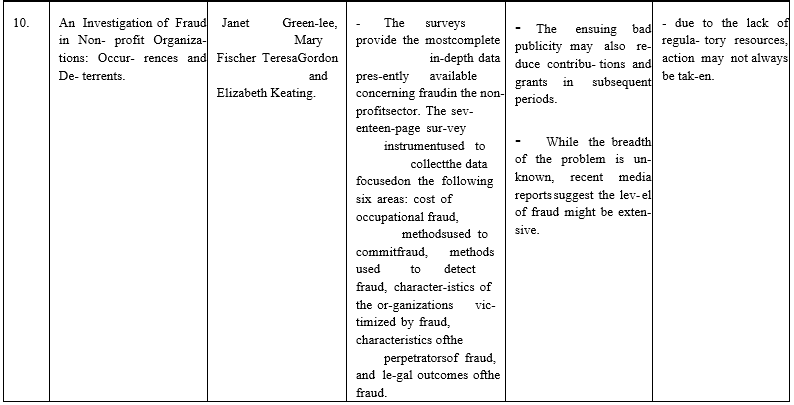
Conclusion
We studied the combination of blockchain technology and philanthropy, a new charity platform model based on blockchain is proposed. In this system, us- ers complete the donation using smart con- tracts. All transactions are recorded on the blockchain to realize traceability of funds, which increase the transparency of chari- ties. The lack of transparency in charity activities could be solved technically with this blockchain charity system, which could increase the public’s trust in charity organizations. Some core components have been realized and verified by a decentral- ized application we have develop. A com- plete charity system based on blockchain in the future is the next step for us.
References
[1] Research on Charity System Based on Blockchain. Hangzhou Institute of Service Engineering, Hangzhou Normal Universi- ty, Hangzhou, author- hubaokun (2020). [2] Research on Bitcoin: A Peer-to-Peer Electronic Cash System. Author: Satoshi Nakamoto (2008). [3] Developing a Reliable Service System of Charity Donation During the Covid-19 Outbreak. HANYANG WU 1,2 AND XIANCHEN ZHU 1 1School of Econom- ics and Management, Nanjing University of Science and Technology, Nanjing 210094, China 2School of Economics and Management, Jilin Institute of Chemical Technology (2020). [4] Blockchain smart contracts: Applica- tions, challenges, and future trends. Au- thor: Shafaq Naheed Khan1 · Faiza Loukil2 · Chirine Ghedira-Guegan3· El- hadj Benkhelifa4 · Anoud Bani-Han (2021). [5] Managing charity 4.0 with Blockchain: a case study at the time of Covid- 19.University G. D’Annunzio of Chieti- Pescara, Viale Pindaro, 42, 65127 Pescara, Italy. Corresponding author: Adalberto Ragone. [6] Review of Distributed Ledgers: The technological Advances behind cryptocur- rency. Author: Suvarna K. Kadam De- partment of Computer Engineering, D. Y. Patil College of Engineering Akurdi (2018). [7] An Overview of Smart Contract and Use cases in Blockchain Technology. Au- thor: Bhabendu Kumar Mahanta, SoumyaShree S Panda, Debasish Jena IIIT Bhubaneswar Odisha, India (2018). [8] A block chain based decentralized ex- change. Author: Harsh Patel. [9] A Study of Private Donation System Based on Blockchain for Transparency and Privacy. Author: junho jeong [Science and Engineering Kongju National University, Cheonan, Rep. of Korea] (2020). [10] An Investigation of Fraud in Non- profit Organizations: Occurrences and De- terrents. Author: Janet Greenlee, Mary Fischer Teresa Gordon and Elizabeth Keat- ing. [The Hauser Centre for Non-profit Or- ganizations Harvard University
Copyright
Copyright © 2022 Prof. Mrs. A. H. Renushe, Miss. Mane Shrutika Vidhyanath, Mr. Jadhav Manish Prakash , Mr. Sonawale Omkar Ganpat, Mr. Jamdade Sourabh Vishnu. This is an open access article distributed under the Creative Commons Attribution License, which permits unrestricted use, distribution, and reproduction in any medium, provided the original work is properly cited.

Download Paper
Paper Id : IJRASET41184
Publish Date : 2022-04-02
ISSN : 2321-9653
Publisher Name : IJRASET
DOI Link : Click Here
 Submit Paper Online
Submit Paper Online

